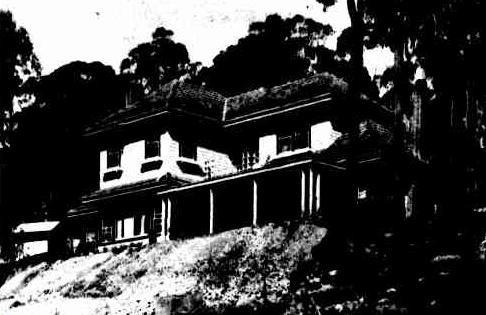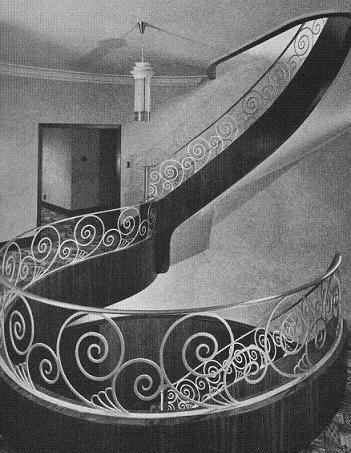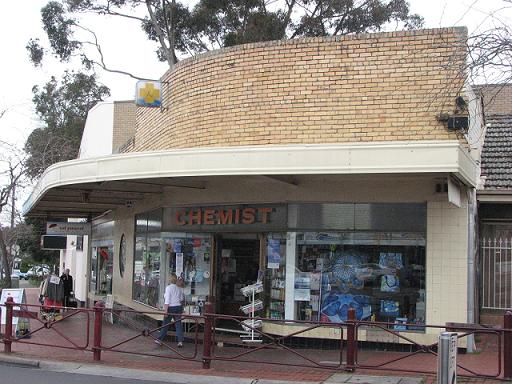Arthur
Edgar Pretty was born in Lilydale in 1903. He initially
studied at Swinburne Technical College, where he completed
the architecture and building course between 1918 and 1922.
He then gained experience as a draftsman, firstly in the city
office of engineer A C Matthews (1923-24) and then with architects
Barlow & Hawkins (1925-26). Pretty transferred thence to the
Public Works Department, and commenced the evening course at the
University of Melbourne Architectural Atelier. Completing his
Diploma of Architectural Design in March 1930, Pretty remained
with the PWD until the end of that year, and then opened his own
architectural office in 1931.
While still employed in the PWD, Pretty appears to carried out a number of bootleg commissions in the Croydon area, where he lived at the time; these projects included new premises for the Croydon Golf Club (1927) and a house for local historian, Muriel McGivern, and her husband (1930). After he formally established his own practice in 1931 - with an office in Main Street, Croydon - Pretty's output was largely concentrated in that semi-rural area on Melbourne's outer eastern fringe. His residential works during this period were typically in the form of modest gable-roofed timber cottages with posted verandahs, casement windows with flower boxes, and other deliberately picturesque elements befitting their semi-rural context; one such example, published in the Argus in 1938, was described as "a very successful adaptation of the modern style in domestic architecture to timber construction".
Pretty's practice continued to focus on the Croydon area until the late 1930s, when he transferred his business to an inner city office at 368 Collins Street, Melbourne. This move coincided with a bold change in Pretty's aesthetic tastes, as he abandoned his earlier cottagey style and began to embrace the more progressive Moderne and even Functionalist idioms, typified by two large flat-roofed brick houses that the designed for members of the prominent Carter family in Werribee. He subsequently designed a similarly modern house for himself in Burke Road North, Ivanhoe, where he lived with his wife, Ellen Mary (Nellie), who died only a few years later, in 1948. The completion of Pretty's own house in 1942 was followed by a prolonged professional hiatus of just over a decade, during which the architect appears to have undertaken no further projects. Evidence suggests that this mysterious gap in his career was related to some type of military service. While Pretty's name is not recorded in the nominal rolls of those who served in the Second World War, a number of secondary sources have referred to him with the title of either Captain or Group Captain - the latter suggesting that Pretty may well have held a senior rank within the RAAF.
In any case, it was not until 1953 that Pretty resumed his private practice. The catalyst for this was reportedly a married couple who, after driving past Pretty's own house in Ivanhoe, were so impressed that they commissioned him to design a similar one for themselves, which was subsequently erected in Bendigo. He went on to complete a few other projects, including a smart modern chemist's shop in his old suburban stomping-ground of Croydon. However, by the end of that year, Pretty had closed his office and moved to Sydney, where he lived in Fraser Street, Lane Cove. Within two years thence, he had moved again, this time to the burgeoning tourist resort town of Surfers Paradise in Queensland. No doubt hoping to exploit this lucrative market, Pretty established and operated his own motel, known as the High Seas. Given that the motel exhibited a high degree of architectural pretension, with its broad-eaved flat roof, vertical timber cladding, stepped facade and bays of multi-paned awning-sash windows, it is highly probable that Pretty designed it himself.
In a letter to the Architects' Registration Board of Victoria, dated November 1955, Pretty advised that he wished to discontinue his registration in that state, but hoped to retain his RVIA membership. He subsequently remained on the membership roll of the Queensland chapter of the RAIA until 1963, when, at the age of 60 years, he presumably retired. Electoral rolls reveal that Pretty and his second wife, Ruth, resided at their Surfers Paradise motel until 1970, when their relocated to a beachfront apartment on the Esplanade. By 1972, the couple had moved thence an apartment at Miami Keys, where Pretty remained living until at least 1977.
While still employed in the PWD, Pretty appears to carried out a number of bootleg commissions in the Croydon area, where he lived at the time; these projects included new premises for the Croydon Golf Club (1927) and a house for local historian, Muriel McGivern, and her husband (1930). After he formally established his own practice in 1931 - with an office in Main Street, Croydon - Pretty's output was largely concentrated in that semi-rural area on Melbourne's outer eastern fringe. His residential works during this period were typically in the form of modest gable-roofed timber cottages with posted verandahs, casement windows with flower boxes, and other deliberately picturesque elements befitting their semi-rural context; one such example, published in the Argus in 1938, was described as "a very successful adaptation of the modern style in domestic architecture to timber construction".
Pretty's practice continued to focus on the Croydon area until the late 1930s, when he transferred his business to an inner city office at 368 Collins Street, Melbourne. This move coincided with a bold change in Pretty's aesthetic tastes, as he abandoned his earlier cottagey style and began to embrace the more progressive Moderne and even Functionalist idioms, typified by two large flat-roofed brick houses that the designed for members of the prominent Carter family in Werribee. He subsequently designed a similarly modern house for himself in Burke Road North, Ivanhoe, where he lived with his wife, Ellen Mary (Nellie), who died only a few years later, in 1948. The completion of Pretty's own house in 1942 was followed by a prolonged professional hiatus of just over a decade, during which the architect appears to have undertaken no further projects. Evidence suggests that this mysterious gap in his career was related to some type of military service. While Pretty's name is not recorded in the nominal rolls of those who served in the Second World War, a number of secondary sources have referred to him with the title of either Captain or Group Captain - the latter suggesting that Pretty may well have held a senior rank within the RAAF.
In any case, it was not until 1953 that Pretty resumed his private practice. The catalyst for this was reportedly a married couple who, after driving past Pretty's own house in Ivanhoe, were so impressed that they commissioned him to design a similar one for themselves, which was subsequently erected in Bendigo. He went on to complete a few other projects, including a smart modern chemist's shop in his old suburban stomping-ground of Croydon. However, by the end of that year, Pretty had closed his office and moved to Sydney, where he lived in Fraser Street, Lane Cove. Within two years thence, he had moved again, this time to the burgeoning tourist resort town of Surfers Paradise in Queensland. No doubt hoping to exploit this lucrative market, Pretty established and operated his own motel, known as the High Seas. Given that the motel exhibited a high degree of architectural pretension, with its broad-eaved flat roof, vertical timber cladding, stepped facade and bays of multi-paned awning-sash windows, it is highly probable that Pretty designed it himself.
In a letter to the Architects' Registration Board of Victoria, dated November 1955, Pretty advised that he wished to discontinue his registration in that state, but hoped to retain his RVIA membership. He subsequently remained on the membership roll of the Queensland chapter of the RAIA until 1963, when, at the age of 60 years, he presumably retired. Electoral rolls reveal that Pretty and his second wife, Ruth, resided at their Surfers Paradise motel until 1970, when their relocated to a beachfront apartment on the Esplanade. By 1972, the couple had moved thence an apartment at Miami Keys, where Pretty remained living until at least 1977.
Select List of Projects
| 1927 1930 1934 1936 1937 1938 1939 1940 1941 1942? 1953 1957? | Clubhouse for Croydon District Golf Club, Croydon Residence for R & M McGivern, 146 Dandenong Road, Croydon Residence, Croydon Pioneers Memorial Gateway, Jindivick Additions to Croydon Mechanics Institute, Croydon Residence, 63 Alto Avenue, Croydon Fish Creek Hotel, Fish Creek Residence, Glen Iris Residence for W Carter, 35-39 Deutgam Street, Werribee Factory, Richmond Residence, Foilacleugh Avenue, Brighton Residence for R Carter (Monleisha), 51-59 Russell Street, Werribee Residence for R Lockwood, 119 Doncaster Road, Balwyn [project only] Residence for self, Burke Road North, Ivanhoe Chemist's shop for Donald Grey, 161 Main Street, Croydon Residence, Ironbark Road, Bendigo High Seas Motel, 7 Enderley Avenue, Surfers Paradise, Queensland [demolished] |
 | |
| Unidentified two-storey timber house at Croydon (1938) |
 | |
| Interior of Walter Carter Residence, Werribee (1939) |
 | |
| Grey & Burns Chemist Shop, Main Street, Croydon (1953) (Photograph by Simon Reeves, Built Heritage Pty Ltd) |
| Select References Alexander McRobbie, The Fabulous Gold Coast (1984). Mike Butcher and Gill Flanders. Bendigo Historic Buildings (1987). |
